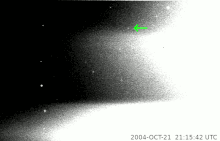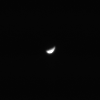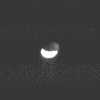Polydeuces (moon)
assumed synchronous[12] : 4 | |
Polydeuces
Discovery

Polydeuces was discovered by the Cassini Imaging Science Team
By 4 November 2004, the Cassini Imaging Science Team obtained more Cassini images of Polydeuces, including two frames taken on 2 November 2004 and another two predating the discovery images by three hours.[4]: 223–226 Preliminary orbit determinations using these images confirmed that Polydeuces was a co-orbital trojan moon residing around Dione's L5 Lagrange point.[4]: 226 With the aid of ephemeris predictions from Polydeuces's newly determined orbit, the Cassini Imaging Science Team was able to identify 52 pre-discovery detections of Polydeuces in Cassini's narrow-angle camera images taken between 9 April 2004 and 9 May 2004.[4]: 226 The International Astronomical Union (IAU) announced the discovery of Polydeuces on 8 November 2004.[16] Besides Polydeuces, Cassini has discovered five other objects orbiting Saturn in 2004: Methone, Pallene, S/2004 S 3, S/2004 S 4, and S/2004 S 6.[17]: 1226–1227
After the discovery announcement, Cassini was retasked to begin targeted observations of Polydeuces in January 2005 to better determine its orbit.[4]: 226 In 2006, researchers found even earlier Cassini pre-discovery images of Polydeuces taken on 2 April 2004.[10]: 695, 702
Name
The name Polydeuces was approved and announced by the IAU Working Group on Planetary System Nomenclature on 21 January 2005.
Orbit

Polydeuces · Helene · Dione · Saturn
Polydeuces is an inner moon of Saturn in a co-orbital configuration with Dione, meaning they share the same orbit.[11]: 261 [19]: 2 Together with Dione and its other co-orbital companion Helene, Polydeuces orbits Saturn in 2.74 days at an average distance of 377,600 km (234,600 mi) from the planet's center, between the orbits of Tethys and Rhea.[8] Due to gravitational perturbations by other nearby moons of Saturn, Polydeuces's orbital radius can vary by ±7,660 km (4,760 mi) over time.[4]: 232 Its orbit is closely aligned with Saturn's equatorial plane with a low orbital inclination of 0.2°.[b]
Polydeuces has a slightly
Polydeuces resides around Dione's L5 Lagrange point trailing 60° behind Dione in its orbit, which makes Polydeuces a trojan moon of Dione. The Lagrange points are locations where the gravitational pulls of Dione and Saturn balance out, allowing for stable co-orbital configurations in Dione's trojans.[20] Dione's other co-orbital moon, Helene, is a trojan residing around the L4 Lagrange point leading 60° ahead of Dione. Trojan moons are not unique to Dione; another large moon of Saturn, Tethys, also has two trojans, named Telesto and Calypso, which reside in its L4 and L5 Lagrange points, respectively.[4]
Because of perturbations by other moons of Saturn, Polydeuces does not stay exactly 60° behind Dione; its
Origin
Polydeuces is thought to have formed by
Dynamical modeling of the trojan moons' formation suggests that Tethys's and Dione's L4 and L5 Lagrange points should have started with similar amounts of material for trojan moons to form with roughly similar sizes.[21]: 2136 However, this is not the case for Dione's trojans, Helene and Polydeuces, whose masses significantly differ by more than an order of magnitude. As of yet, this mass asymmetry in Dione's L4 and L5 trojans remains unexplained.[21]: 2139
Physical characteristics
As of 2020[update], the most recent estimate for Polydeuces's dimensions is 3.50 km × 3.10 km × 2.62 km (2.17 mi × 1.93 mi × 1.63 mi), based on resolved Cassini imagery of the moon from 2015.
Little is known about Polydeuces's other physical properties because it was never approached up close by Cassini or any other space mission to Saturn.[19]: 3 Because of its very small size, Polydeuces's gravitational perturbations on the trajectory of Cassini spacecraft and other Saturnian moons are negligible, which prevents the measurement of the moon's mass and density.[9]: 5 In spite of this, researchers assume that Polydeuces has a density similar to those of Saturn's small inner moons, whose average density is 0.5 g/cm3,[14][15]: 3 [12]: 2 [19]: 2
Polydeuces's small size makes it prone to disruption by impact events. Depending on the size-frequency of impactors in the Saturnian system, Polydeuces is predicted to have suffered at least one disruptive impact in the last one billion years.[12]: 11 This implies that Polydeuces is either very young with an age of less than one billion years, or it is a primordial moon that has consistently reaccreted from each disruptive impact over the Saturnian system's 4.5 billion-year lifespan.[12]: 13
Polydeuces has a bright and likely smooth surface due to the accumulation of fine water ice particles from the surrounding
Exploration
Cassini is the only space mission to Saturn that has made targeted observations of Polydeuces.
See also
- Telesto and Calypso, trojan moons of Tethys at its L4 and L5 Lagrange points, respectively
- Janus and Epimetheus, two inner moons of Saturn in a co-orbital exchange orbit with each other
Notes
- ^ a b Members of the Cassini Imaging Science Team include (in alphabetical surname order): Andre Brahic, Joe Burns, Tony DelGenio, Luke Dones, Andy Ingersoll, Torrence Johnson, Alfred McEwen, Carl D. Murray, Gerhard Neukum, Carolyn Porco, Steve Squyres, Peter Thomas, Joe Veverka, and Bob West.[3]
- ^ a b The mean orbital inclination is given with respect to the Polydeuces's local Laplace plane.[8][9]: 9 Conincidentally, the Laplace plane inclination value is close to the mean orbital inclination with respect to Saturn's equator, given as 0.1774° in Spitale et al. (2006), Table 6.[10]: 695, 698
- ^ Volume calculated from Polydeuces's volume-equivalent sphere radius of 1.53±0.20 km given by Hedman et al. (2020).[13]: 7
- ^ Mass calculated by multiplying Polydeuces's volume with its assumed density of 500 kg/m3 according to the formula .
- ^ Surface gravity g is calculated from the formula , where G is the semi-axis if nonspherical). For Polydeuces, its mass is approximately 8×1012 kg for an assumed density of 500 kg/m3. For Polydeuces's longest semi-axis of 1.75 km,[13]: 7 the surface gravity would be about 0.0002 m/s2, while for Polydeuces's shortest (polar) semi-axis of 1.31 km, the surface gravity would be about 0.0003 m/s2.
- ^ Escape velocity ve is calculated from the formula , where G is the semi-axis if nonspherical). For Polydeuces, its mass is approximately 8×1012 kg for an assumed density of 500 kg/m3. For Polydeuces's longest semi-axis of 1.75 km,[13]: 7 the escape velocity would be about 0.0008 km/s, while for Polydeuces's shortest (polar) semi-axis of 1.31 km, the escape velocity would be about 0.0009 km/s.
- ^ The discovery announcement of Polydeuces in IAUC 8432 mistakenly reports that it was discovered in narrow-angle Cassini images on 21 October 2004.[16] All Cassini images containing Polydeuces on 21 October 2004 were taken with the wide-angle camera, as reported in Murray et al. (2005), Table 1[4]: 224–225 and shown in NASA's Outer Planets Unified Search tool for archived Cassini data.
- ^ The angular distance minimum and maximum are calculated by adding –60° (negative because L5 is behind Dione) to Polydeuces's libration amplitudes of –31.41° and +26.06° given by Spitale et al. (2006)[10]: 702
- ^ Hedman et al. (2020) list all resolved Cassini observations of Polydeuces in Table 7, but they only give the image IDs of these observations.[13]: 31 Inputting these image IDs into NASA's Outer Planets Unified Search query form shows the date on which these images were taken.
References
- ^ "Planetary Satellite Discovery Circumstances". Jet Propulsion Laboratory. 23 May 2023. Archived from the original on 27 September 2021. Retrieved 5 June 2023.
- ^ a b "Planet and Satellite Names and Discoverers". Gazetteer of Planetary Nomenclature. USGS Astrogeology Science Center. Archived from the original on 21 August 2014. Retrieved 5 June 2023.
- ^ "Cassini Imaging Science Team". Cassini Imaging Central Laboratory for Operations. NASA. Archived from the original on 5 July 2022. Retrieved 13 June 2023.
- ^ S2CID 120102820.
- ^ "Polydeuces". Lexico UK English Dictionary. Oxford University Press. Archived from the original on 24 October 2021.
- ^ Lundström (1997) Eranos, v. 95
- ^ Levin (1971) Apollonius' Argonautica, v. 1, p. 139
- ^ a b c d "Planetary Satellite Mean Orbital Parameters". Jet Propulsion Laboratory. Archived from the original on 6 October 2021. Retrieved 5 June 2023.
- ^ S2CID 252992162. 199.
- ^ S2CID 26603974.
- ^ S2CID 26603974.
- ^ S2CID 198473514. A12.
- ^ S2CID 209414585. 129.
- ^ a b "Polydeuces By the Numbers". Solar System Exploration. NASA. Archived from the original on 14 June 2023. Retrieved 13 June 2023.
- ^ S2CID 118604203.
- ^ Bibcode:2004IAUC.8432....1P. Archivedfrom the original on 29 May 2012. Retrieved 31 December 2011.
- S2CID 1058405. Archived from the original(PDF) on 13 February 2012.
- ^ Bibcode:2005IAUC.8471....6G. Archivedfrom the original on 25 June 2013. Retrieved 31 December 2011.
- ^ S2CID 197474587. 113355.
- ^ "Polydeuces In Depth". Solar System Exploration. NASA. 19 December 2019. Archived from the original on 6 June 2023. Retrieved 11 June 2023.
- ^ S2CID 119119468.
- ^ S2CID 140539103.
- ^ a b c "Cassini Tour Event Summary: Planned Observations of Small Satellites". PDS Atmospheres Node. NASA. Archived from the original on 6 June 2023. Retrieved 6 June 2023.
- S2CID 26603974.
External links
- Polydeuces In Depth, NASA Solar System Exploration, updated 19 December 2019
- PIA08209: New Moon, NASA Photojournal, 28 June 2006
- Cassini finds treasures among Saturn's rings, moons, Cassini news release via Spaceflight Now, 24 February 2005





